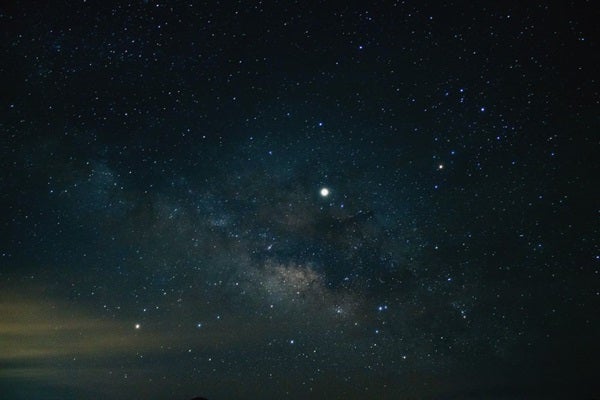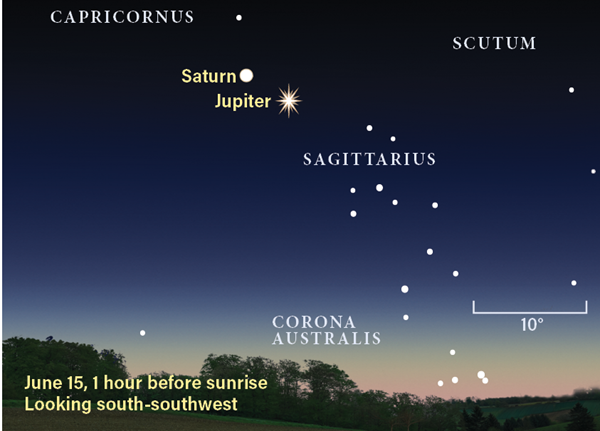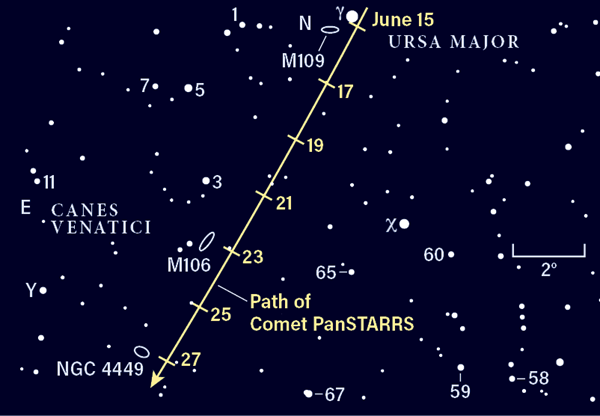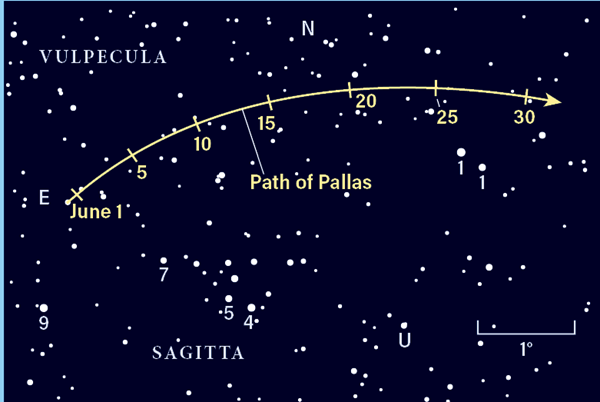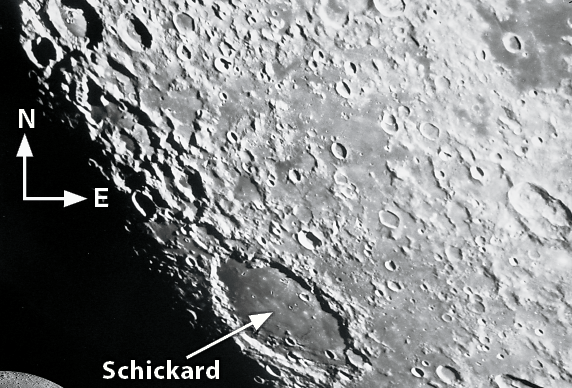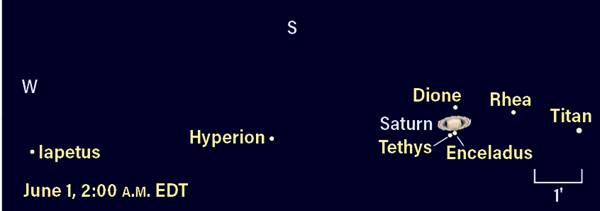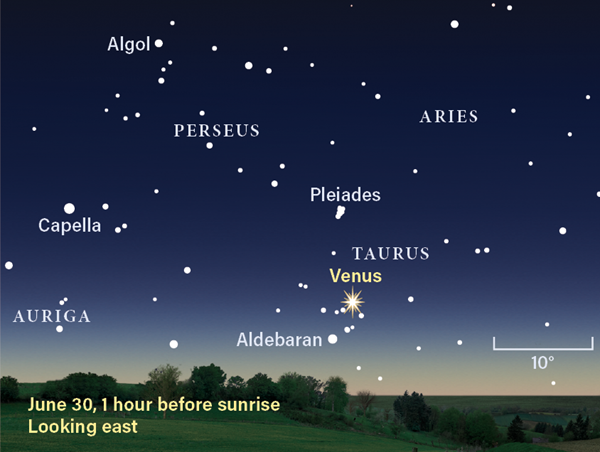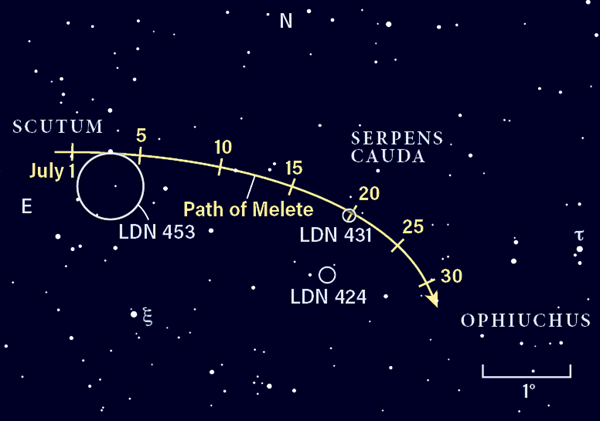On July 1, a gibbous Moon is already in the southeastern sky as night falls. As the sky darkens between 9:30 and 10 P.M. local time, you’ll spot Antares, the brightest star in Scorpius, about 10° southeast of the Moon. At first, no planets seem visible, but both Jupiter and Saturn rise in the southeast within an hour of sunset.
Jupiter stands 15° high on July 1 by 11 P.M. local time, shining at a brilliant magnitude –2.7. It reaches opposition on July 14, remaining visible all night at a slightly brighter magnitude –2.8. It’s in the eastern part of Sagittarius, away from the brightest regions of the Milky Way and roughly midway between 2nd-magnitude Nunki (Sigma [σ] Sagittarii) and 3rd-magnitude Dabih (Beta [β] Capricorni). Jupiter moves 4° westward relative to the stars in Sagittarius during July.
As the solar system’s largest planet reaches its closest point to Earth this month, Jupiter is well placed for telescope observations. It reaches its peak elevation near 30° (for those near 40 degrees north latitude) in the south around local midnight (1 A.M. local daylight saving time).
The Galilean satellites — Io, Europa, Ganymede, and Callisto — now shine at their brightest. The angle between a satellite and its corresponding shadow decreases through opposition and switches afterward, when the leading shadow during a transit prior to opposition becomes a trailing shadow. Eclipses and occultations of these moons occur frequently, so check Jupiter regularly each evening. At opposition, eclipses as the moons pass into Jupiter’s shadow occur at the same time as occultations.
Saturn lies 6° east of Jupiter on July 1 and nearly 8° east by July 14, thanks to Jupiter’s brisker retrograde motion west compared with the more distant Saturn. The ringed planet reaches opposition on July 20 at magnitude 0.1.
It’s challenging to figure out what to observe with both giant planets beside each other. One option is to focus on Jupiter first, making note of its clouds, then swing to Saturn to check out its moons and atmosphere. Some minutes later, swing back to Jupiter and you’ll notice the cloud patterns have changed. (Yes, they move that quickly.) The moons’ relative configuration may have also changed.
Saturn’s disk spans 19″ and the rings’ major axis stretches nearly 42″. The planet’s polar axis tilts 21° toward us, revealing the northern side of the ring system and offering views of the three major rings: the outer main A ring, the brighter central B ring, and the dusky inner C ring. The A and B rings are separated by the 2,980-mile-wide Cassini division, visible in a small scope.
Saturn’s wide-ranging moon Iapetus reaches inferior conjunction with the planet on July 28, as it moves from its fainter eastern elongation early in the month and brightens to magnitude 11. On July 27 and 28, it lies 1′ south of Saturn, while Titan, Saturn’s largest and brightest moon, stands 3′ west of the planet. You’ll find Titan due north of Saturn July 15 and 31, and due south on July 7 and 23. A trio of 10th-magnitude moons orbit closer to the rings: Tethys, Dione, and Rhea.
Pluto also lies in this region. On July 1, the magnitude 14.6 dwarf planet lies 41′ south of Jupiter. By late July, Pluto stands 3.2° due east of the fast-moving giant. Pluto is hard to see even with most telescopes, but digital cameras will detect it.
Neptune in northwestern Aquarius is a relatively easy binocular object at magnitude 7.9. It rises soon after local midnight July 1 and climbs to a decent altitude a few hours later. In the predawn sky the first week of July, Neptune stands between 11° and 15° west of Mars. The closest bright guide star is 4th-magnitude Phi (φ) Aquarii. Grab a pair of binoculars and place Phi at the right side of your field of view; in 7×50 or 10×50 binoculars, Neptune will stand about 4° east-northeast of the star. On July 10, Neptune lies nearly 5° north of the gibbous Moon. A telescope reveals its tiny 2″-wide bluish disk.
Increasing in brightness and apparent diameter in the morning sky, Mars opens the month at magnitude –0.5 in southwestern Pisces, rising soon after midnight local time. It brightens to magnitude –1.1 by July 31 and rises just after 11 P.M. local time. Its disk grows dramatically from 12″ to 15″ this month, as the distance between Earth and Mars decreases.
In the hour before dawn — the best time to view it — Mars stands 30° high in the southeast in early July. By July 31, the Red Planet reaches 45° altitude, making this apparition more favorable for Northern Hemisphere observers than its 2018 perihelic opposition.
Mars starts the month in southwestern Pisces, 17° south of Algenib in the Square of Pegasus, and moves through the northwest corner of Cetus the Whale between July 8 and 26. It crosses the celestial equator into the northern half of the sky on July 11. The same morning, Mars stands 6° northeast of a waning gibbous Moon.
The martian disk swells from 84 percent lit to 86 percent during July; as it does, fine detail on the surface is observable with smaller telescopes. It’s always a small disk and atmospheric conditions greatly affect what you will see. High-speed video capture is the best way to record fine details. Observers should be on the lookout for dust storms that can erupt as the martian southern hemisphere approaches summer.
Uranus rises two hours before dawn on July 1 in Aries the Ram, located roughly midway between its brightest star, Hamal, and Menkar, the brightest star in Cetus. The planet shines at magnitude 5.8 with no other bright stars nearby. It’s best spotted in binoculars, while a telescope easily reveals the greenish-colored disk spanning 3.5″. On July 14, Uranus stands 4.8° due north of a waning crescent Moon.
At 5 A.M. on July 1, brilliant Venus (magnitude –4.6) stands 8° high, adjacent to the Hyades star cluster. The Pleiades (M45) are 10° directly above the planet. Venus reaches greatest brilliancy (magnitude –4.7) on July 10. On July 12, it passes 1° north of Aldebaran, the brightest star in Taurus the Bull. In the July 16 and 17 predawn sky, a waning crescent Moon adds more beauty to the scene, first located 5° above the Hyades and then 3.5° northeast of Venus the next morning. By July 31, Venus stands 2.3° southeast of Zeta (ξ) Tauri, the southern horn of the Bull.
Watch the fattening crescent of Venus through any telescope — it grows from 19 percent illuminated on July 1 to 43 percent on July 31. Meanwhile, the disk of the planet shrinks from 43″ to 27″ in diameter as its distance from Earth increases.
Mercury reaches greatest elongation west (20°) at magnitude 0.3 on July 22. Three days earlier, on the 19th, it shines at magnitude 0.8 and stands 5° to the right of the waning crescent Moon, which will help you spot the faint planet in brightening twilight. Both rise soon after 4:30 A.M. local time and should be visible above the northeastern horizon 30 minutes later.
Mercury’s visibility improves as it brightens to magnitude –0.1 on July 25. It’s in Gemini and the pair of bright stars in the Twins rise with Mercury further south along the horizon. On July 31, it is easier still to see at magnitude –0.7, forming a nice trio of objects with Pollux (7° northeast) and Castor nearby.
Rising Moon: Punched, flooded, sprayed, and strafed
Much of the Moon’s history is encapsulated in one feature: the crater Schickard, way down in the lunar southwest. Protective measures are necessary to carry out this observation. Screw in a dark filter, mask off part of your scope’s aperture, or pump up the magnification to reduce the glare of an almost-full lunar disk.
Start on the evening of the 2nd, when the rays of sunlight strike the flooded crater at a glancing angle, highlighting the differences in height among the smaller features. This is an old crater, its rounded rim pounded down across the ages. The splatter of smaller craters across the smooth floor sport the classic sharp edges of relative youth. The western wall, steep at the instant of formation, slumped abruptly down into terraces that remain visible to this day. Disappearing shadows under a climbing Sun in the next two evenings almost erase these features.
During the following nights, Schickard transforms into a two-faced, striped crater, with an unusual swath of lighter gray painted across the middle of this timeworn feature. The 140-mile-wide depression was carved out some 4 billion years ago as bombardment was ending. Lava soon welled up and covered its central peaks. Then the giant Orientale impact event to the west sprayed the whole region with lighter-hued material. A final surge of lava managed to cover the northern and southern portions but did not rise enough to erase this lighter stripe.
When the Sun returns on August 1, the rough lunar landscape casts plenty of shadows to camouflage the different shades of material. However, in a couple of days the stripe will return to prominence once more.
Meteor Watch : Summer meteors shine
July is a good month for meteor observing, with warm weather and increasing hours of darkness as the month progresses. Some minor showers are active, all contributing to an overall increase in summertime meteor rates. A Full Moon occurs on July 5, so the best viewing is later in the month, when the Southern Delta Aquariids are active (July 12 to August 23).
New Moon occurs on July 20 and the predawn hours are the best time to look for shower members, although sporadic meteors can occur any time of night. In late July, the Perseids begin, quietly at first, but the waxing Moon interferes most of the night in the latter days of the month.
Comet Search: Graying in time
Brighter than many of Virgo’s Messier galaxies, Comet PanSTARRS (C/2017 T2) will appear in a 4-inch scope under a country sky. Follow the 9th- to 10th-magnitude fuzz across the Milky Way’s north polar region as it gradually fades on its return to the Oort cloud.
On June 30, our ball of ice and dust is nearly equal to the interesting NGC 4485/90 pair. The Moon interferes in early July; on the 10th and 11th, leverage the two hours of evening darkness to jump between PanSTARRS and the nearby galaxies of Coma Berenices. July is also globular cluster season, so compare M53 and NGC 5053 to the comet for brightness, shape (morphology), and character. Observe intently at different magnifications to examine which objects have well-defined edges, bright cores, and fading flanks. The classic green halo of ionized gas around the coma is powering down as the comet continues to pull away from the Sun, but enough output remains for imagers’ sensitive pixels.
Perfectly timed for New Moon, the periodic visitor 88P/Howell scoots less than 2° from blue-white Spica. It glows at a faint magnitude 10 to 11 this month, but will pick up to 9 when it arrives at perihelion in late September.
Locating Asteroids: Standing out against the darkness
The easiest time to pick out an asteroid is when the backdrop goes black. The Great Rift splitting our summer Milky Way does just that. The prominent Scutum Star Cloud just below Aquila sports a metaphorical cliff on its western (right) edge, where a field chock-full of stars suddenly empties to a couple of dozen. The dark swath of dust and gas that cloaks the bulge of our galaxy is so dense it caught the attention of E.E. Barnard, pioneer of dark nebula photography.
Beginning at the fabulous star cluster Messier 11, push your scope westward past a small inky circle cataloged as Barnard 103 and onto the near emptiness. 56 Melete starts out the month just east of a 6.3-magnitude star that it grazes on the 3rd. Look farther west to find a cat’s eyes of 8th-magnitude stars — Melete will skim south of the pair on the 13th. Those two nights will be perfect for catching the asteroid’s change of position in a three-hour period.
You’ll need to be under dark country skies to “aha!” the “nothing” of the dark nebula, as well as other Barnard objects field after field to the south. Melete also crosses a series of lesser-known Lynds dark nebulae — 453, 431, and 424 — which you can recognize by the lack of faint stars.
Spanning some 70 miles in diameter, this main belt space rock was discovered by Hermann Goldschmidt in 1857 and named after the Greek muse of meditation.

